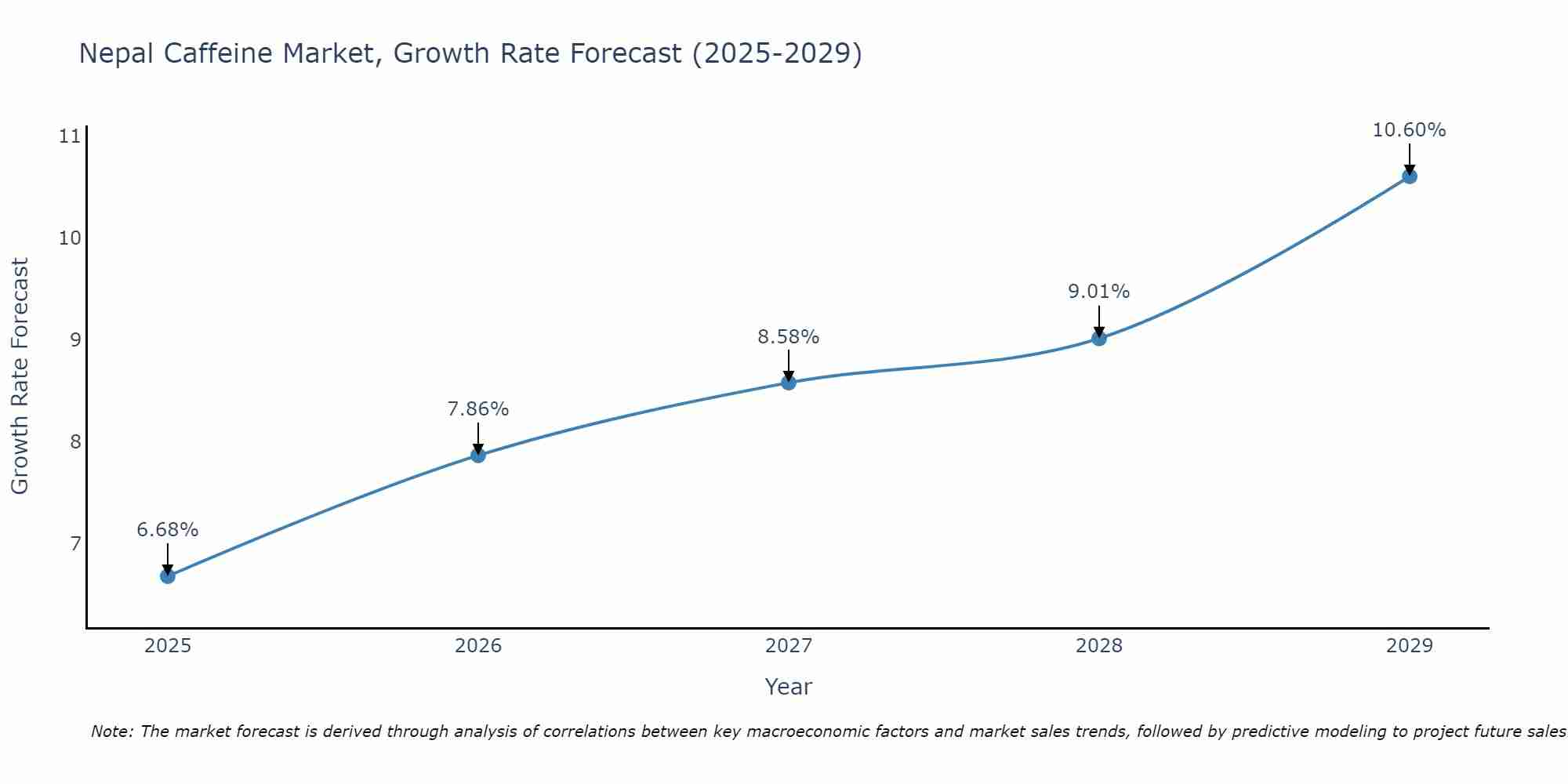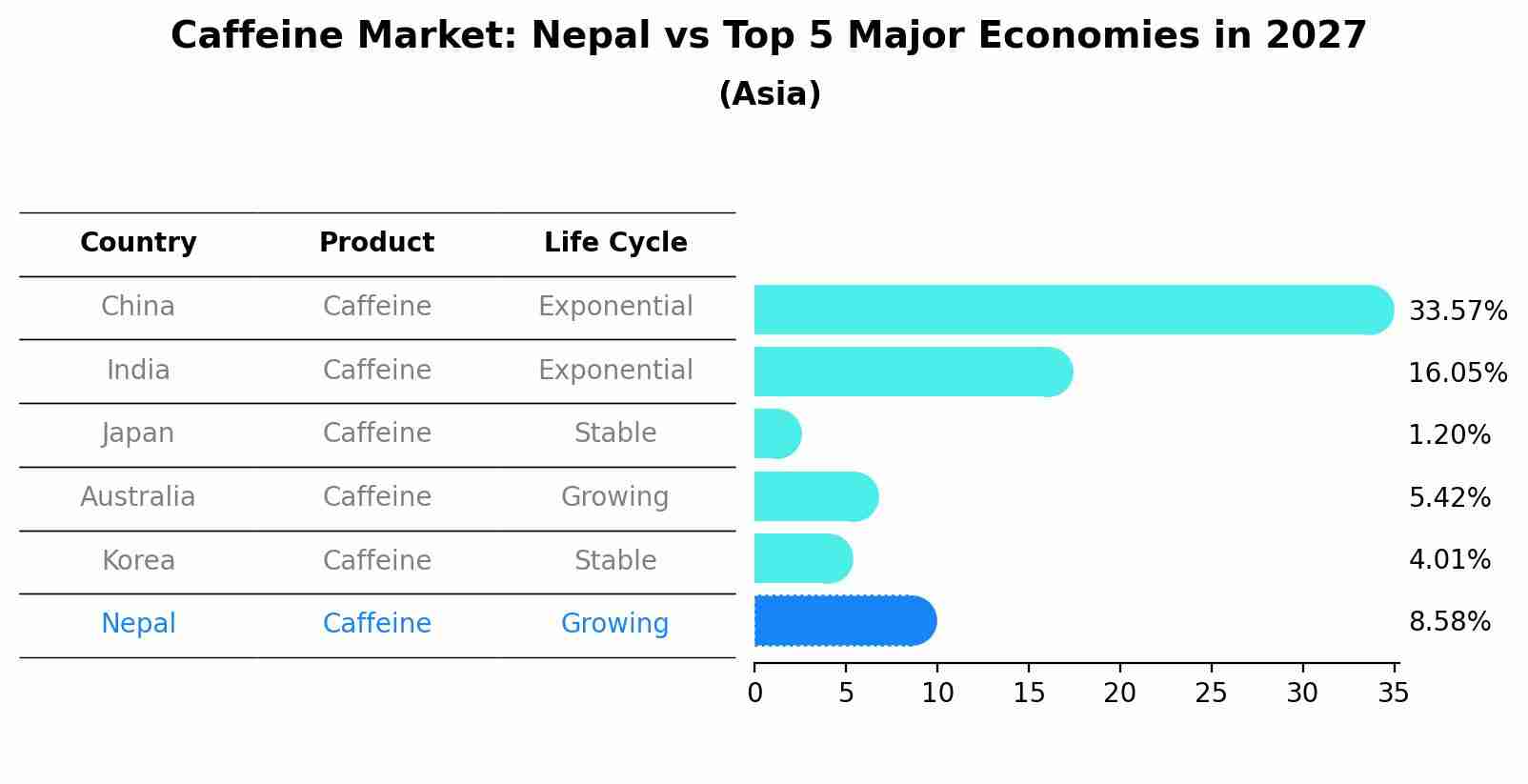Nepal Caffeine Market (2025-2031) Outlook | Companies, Revenue, Industry, Trends, Growth, Analysis, Forecast, Value, Share, Size
| Product Code: ETC110035 | Publication Date: Jun 2021 | Updated Date: Jun 2025 | Product Type: Report | |
| Publisher: 6Wresearch | Author: Bhawna Singh | No. of Pages: 70 | No. of Figures: 35 | No. of Tables: 5 |
Nepal Caffeine Market Size Growth Rate
The Nepal Caffeine Market is poised for steady growth rate improvements from 2025 to 2029. The growth rate starts at 6.68% in 2025 and reaches 10.60% by 2029.

Caffeine Market: Nepal vs Top 5 Major Economies in 2027 (Asia)
Nepal's Caffeine market is anticipated to experience a growing growth rate of 8.58% by 2027, reflecting trends observed in the largest economy China, followed by India, Japan, Australia and South Korea.

Nepal Caffeine Market Overview
The Nepal Caffeine Market is experiencing steady growth due to the rising popularity of coffee consumption among the country`s increasingly urbanized population. Coffee shops and cafes are becoming more prevalent in urban areas, catering to a growing demand for specialty coffee beverages. Additionally, the market for packaged coffee products, such as instant coffee and ground coffee, is expanding as more consumers seek convenience and quality in their coffee choices. With a strong cultural tradition of tea consumption, Nepal also presents opportunities for growth in the tea market, particularly in specialty tea blends and flavored teas. Overall, the Nepal Caffeine Market is poised for further development and innovation as consumer preferences evolve and the food and beverage industry continues to expand in the country.
Nepal Caffeine Market Trends
In Nepal, the caffeine market is witnessing a growing trend towards specialty coffee consumption, with an increasing number of coffee shops offering a variety of high-quality, locally sourced coffee beans. Consumers are becoming more discerning about the origin and processing methods of their coffee, leading to a demand for single-origin and organic coffee products. Additionally, there is a rising interest in alternative caffeine sources such as specialty teas, matcha, and energy drinks among health-conscious consumers. The market is also seeing a shift towards convenient and on-the-go caffeine products like ready-to-drink coffee beverages and instant coffee mixes. Overall, there is a growing awareness and appreciation for different caffeine products in Nepal, driven by evolving consumer preferences and a desire for unique and premium coffee experiences.
Nepal Caffeine Market Challenges
In the Nepal caffeine market, some challenges include limited awareness and understanding of different types of caffeinated products among consumers, leading to a lack of demand diversification beyond traditional tea and coffee. Additionally, the market may face supply chain disruptions due to factors such as geographical constraints, infrastructural limitations, and political instability, affecting the availability and distribution of caffeine products. Furthermore, price fluctuations and increasing competition from international brands could pose challenges for local caffeine producers and retailers in maintaining market share and profitability. To navigate these challenges, stakeholders in the Nepal caffeine market may need to focus on education and marketing efforts to expand consumer knowledge and preferences, invest in improving supply chain efficiency, and innovate to differentiate their products in a competitive landscape.
Nepal Caffeine Market Investment Opportunities
In the Nepal Caffeine Market, there are several promising investment opportunities worth exploring. One potential avenue is to invest in coffee plantations or farms in Nepal, as the country has a growing coffee industry with increasing demand for high-quality beans both domestically and internationally. Another opportunity lies in the coffee processing and export sector, where investing in modern processing facilities and distribution channels can help capitalize on the expanding market. Additionally, investing in coffee shops or cafes that offer specialty Nepali coffee blends could also be lucrative, catering to the rising trend of coffee culture in the country. Overall, the Nepal Caffeine Market presents diverse investment prospects across the coffee value chain, from cultivation to consumption, for investors looking to tap into this evolving market.
Nepal Caffeine Market Government Policy
The Nepal government does not have specific policies directly targeting the caffeine market; however, the country has regulations on food safety and labeling that indirectly impact caffeine-containing products. The Food Act and Regulations require proper labeling of ingredients, including caffeine content, to ensure consumer safety and transparency. Additionally, the government monitors the quality of imported and domestically produced caffeine products to maintain industry standards. The government also promotes sustainable agriculture practices, which could impact caffeine production in the country. Overall, while there are no specific policies targeting the caffeine market, the government`s regulations on food safety, labeling, and agriculture practices play a significant role in regulating the industry in Nepal.
Nepal Caffeine Market Future Outlook
The Nepal caffeine market is expected to experience steady growth in the coming years, driven by increasing consumer awareness about the health benefits of caffeine, changing lifestyle patterns, and the rising popularity of coffee culture in the country. With a growing young population and a rising middle class with higher disposable incomes, there is a growing demand for caffeinated beverages such as coffee and tea. Additionally, the trend towards more convenient and on-the-go consumption options is likely to further boost the market. However, challenges such as fluctuating coffee prices, limited availability of high-quality beans, and competition from other beverage options may impact the market growth. Overall, the Nepal caffeine market presents opportunities for innovation and product diversification to cater to evolving consumer preferences.
Key Highlights of the Report:
- Nepal Caffeine Market Outlook
- Market Size of Nepal Caffeine Market, 2021
- Forecast of Nepal Caffeine Market, 2031
- Historical Data and Forecast of Nepal Caffeine Revenues & Volume for the Period 2021 - 2031
- Nepal Caffeine Market Trend Evolution
- Nepal Caffeine Market Drivers and Challenges
- Nepal Caffeine Price Trends
- Nepal Caffeine Porter's Five Forces
- Nepal Caffeine Industry Life Cycle
- Historical Data and Forecast of Nepal Caffeine Market Revenues & Volume By Type for the Period 2021 - 2031
- Historical Data and Forecast of Nepal Caffeine Market Revenues & Volume By Natural Caffeine for the Period 2021 - 2031
- Historical Data and Forecast of Nepal Caffeine Market Revenues & Volume By Synthetic Caffeine for the Period 2021 - 2031
- Historical Data and Forecast of Nepal Caffeine Market Revenues & Volume By Applications for the Period 2021 - 2031
- Historical Data and Forecast of Nepal Caffeine Market Revenues & Volume By Pharmaceuticals for the Period 2021 - 2031
- Historical Data and Forecast of Nepal Caffeine Market Revenues & Volume By Food for the Period 2021 - 2031
- Historical Data and Forecast of Nepal Caffeine Market Revenues & Volume By Beverages for the Period 2021 - 2031
- Historical Data and Forecast of Nepal Caffeine Market Revenues & Volume By Flavours and Fragrances for the Period 2021 - 2031
- Nepal Caffeine Import Export Trade Statistics
- Market Opportunity Assessment By Type
- Market Opportunity Assessment By Applications
- Nepal Caffeine Top Companies Market Share
- Nepal Caffeine Competitive Benchmarking By Technical and Operational Parameters
- Nepal Caffeine Company Profiles
- Nepal Caffeine Key Strategic Recommendations
Frequently Asked Questions About the Market Study (FAQs):
- Single User License$ 1,995
- Department License$ 2,400
- Site License$ 3,120
- Global License$ 3,795
Search
Thought Leadership and Analyst Meet
Our Clients
Related Reports
- Afghanistan Apparel Market (2026-2032) | Growth, Outlook, Industry, Segmentation, Forecast, Size, Companies, Trends, Value, Share, Analysis & Revenue
- Canada Oil and Gas Market (2026-2032) | Share, Segmentation, Value, Industry, Trends, Forecast, Analysis, Size & Revenue, Growth, Competitive Landscape, Outlook, Companies
- Germany Breakfast Food Market (2026-2032) | Industry, Share, Growth, Size, Companies, Value, Analysis, Revenue, Trends, Forecast & Outlook
- Australia Briquette Market (2025-2031) | Growth, Size, Revenue, Forecast, Analysis, Trends, Value, Share, Industry & Companies
- Vietnam System Integrator Market (2025-2031) | Size, Companies, Analysis, Industry, Value, Forecast, Growth, Trends, Revenue & Share
- ASEAN and Thailand Brain Health Supplements Market (2025-2031) | Strategy, Consumer Insights, Analysis, Investment Trends, Opportunities, Growth, Size, Share, Industry, Revenue, Segments, Value, Segmentation, Supply, Forecast, Restraints, Outlook, Competition, Drivers, Trends, Demand, Pricing Analysis, Competitive, Strategic Insights, Companies, Challenges
- ASEAN Bearings Market (2025-2031) | Strategy, Consumer Insights, Analysis, Investment Trends, Opportunities, Growth, Size, Share, Industry, Revenue, Segments, Value, Segmentation, Supply, Forecast, Restraints, Outlook, Competition, Drivers, Trends, Demand, Pricing Analysis, Competitive, Strategic Insights, Companies, Challenges
- Europe Flooring Market (2025-2031) | Outlook, Share, Industry, Trends, Forecast, Companies, Revenue, Size, Analysis, Growth & Value
- Saudi Arabia Manlift Market (2025-2031) | Outlook, Size, Growth, Trends, Companies, Industry, Revenue, Value, Share, Forecast & Analysis
- Uganda Excavator, Crane, and Wheel Loaders Market (2025-2031) | Strategy, Consumer Insights, Analysis, Investment Trends, Opportunities, Growth, Size, Share, Industry, Revenue, Segments, Value, Segmentation, Supply, Forecast, Restraints, Outlook, Competition, Drivers, Trends, Demand, Pricing Analysis, Competitive, Strategic Insights, Companies, Challenges
Industry Events and Analyst Meet
Whitepaper
- Middle East & Africa Commercial Security Market Click here to view more.
- Middle East & Africa Fire Safety Systems & Equipment Market Click here to view more.
- GCC Drone Market Click here to view more.
- Middle East Lighting Fixture Market Click here to view more.
- GCC Physical & Perimeter Security Market Click here to view more.
6WResearch In News
- Doha a strategic location for EV manufacturing hub: IPA Qatar
- Demand for luxury TVs surging in the GCC, says Samsung
- Empowering Growth: The Thriving Journey of Bangladesh’s Cable Industry
- Demand for luxury TVs surging in the GCC, says Samsung
- Video call with a traditional healer? Once unthinkable, it’s now common in South Africa
- Intelligent Buildings To Smooth GCC’s Path To Net Zero


















